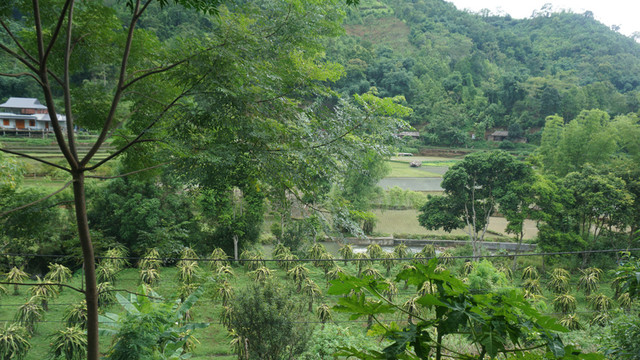Gender and biodiversity conservation – progress and future directions
Gender is fundamental to IIED’s mission, with our research aiming, as a minimum, to be gender aware and sensitive. But what progress towards achieving gender equality has been made in the area of biodiversity conservation? A recent IIED webinar discussed the question.


Maria Lourdes Alvarez is a warden monitoring fishing activity at Decalve Marine Sanctuary, a Marine Protected Area in the Calamianes Islands in the Philippines (Photo: Asuncion Sia/USAID, Creative Commons via Flickr)
Over the last three years an internal network of IIED Gender Equality Champions has been leading our gender ambition, helping staff to think about how we can become gender transformative in our work.
We see gender transformative efforts as those that go beyond promoting equitable sharing of benefits for women, to actively seeking to shift power dynamics. For example, by promoting shared power and control over resources.
A gender transformative project considers the three dimensions of equity – recognition, procedure and distribution using a gendered perspective.
IIED is running a series of events interrogating gender in relation to international initiatives. As part of the series, earlier this month we focused on the Convention on Biological Diversity (CBD) and hosted a webinar on gender and biodiversity conservation. We considered what progress has been made over the past 15 years to achieving gender equality and equity and whether change was genuine or theoretical.
Consultant Andrea Quesada, formerly of the Women’s Environment and Development Organisation, discussed gender at the CBD COP; Helen Anthem, from Fauna and Flora International, shared thoughts from a conservation NGO’s perspective, and IIED's Phil Franks gave us a researcher point of view.
Where speakers identified progress, we asked them to think about the factors that had supported change, and those that had placed constraints.
I was particularly interested to understand from our speakers what difference gender equality and equity made to achieving social and conservation outcomes? I know from my own research that there is limited evidence linking the two.
We also asked speakers to think about the future. What were the goals, opportunities or challenges they saw for making progress on gender equality and equity in biodiversity conservation? You can watch the presentations from the webinar in the playlist below, or on IIED's YouTube channel.
Gender and the CBD
Andrea Quesada described the CBD as “one of the most gender sensitive multi-environmental agreements in the world”. She highlighted that gender first started to trickle into the CBD decisions in 1996, way before the UNFCCC and the Convention on Desertification. And in 2010, at CBP COP10 in Nagoya, there were no less than 13 gender related decisions – a record to date.
The CBD is the first convention to have a Gender Action Plan, which has had a positive impact on national biodiversity strategy and action plans (NBSAPs) worldwide: between 1993 and 2016, 56% of the 256 NBSAPs produced included references to women or gender.
The challenge, however, is that many of the references to gender at the international and national level are high-level principles that relate to issues of recognition and procedure. Andrea stressed that what is lacking is detail on implementing activities for improving gender equality and equity, and more on-the-ground guidance and support for local biodiversity and gender experts.
A conservation NGO’s perspective
Helen opened her talk by acknowledging the roots of the international conservation movement in the colonial era. Conservation policy has traditionally been the realm of men and this had led to historical exclusions of women in conservation.
While Flora and Fauna International was conceived in 1903, it had gone through a journey – particularly over the last five years – and today there are more women on the management board than men.
Three of Helen’s reflections stood out for me:
- Women and men are not a homogenous group. Gender interacts with other factors of social diversity to create issues of marginalisation and inequality. Conservation NGOs often forget this!
- Some people share a misguided fear of challenging local culture. We can work on gender in a culturally sensitive way by working with women and men and supporting them to effect change at a pace with which they are comfortable, and
- Are we talking about women or gender? There is a tendency for conservation NGOs to focus solely on women rather than gender. It is necessary to have women’s projects, given women’s disadvantages, but on their own they are unlikely to challenging existing gender norms and dynamics.
Gender and conservation: what does a researcher think?
Phil covered three case studies from the perspective of gender – Arabuko Sokoko Forest in Kenya, Mara North Conservancy in Kenya and the three generations of Community Forestry in Nepal. For each case study, he reflected on the extent to which practice had been gender sensitive/aware, gender responsive and gender transformative.
Phil poses two insightful questions to us. The first related to equity vs equality in the conservation sector: might there be instances when its more appropriate to work towards equity rather than equality?
The second related to whether we should be responding to moral or instrumental arguments for supporting gender equality in biodiversity conservation. Specifically, he asked: “If contributing to human wellbeing is one goal of conservation, and respecting human rights is a universal obligation – is gender equality to be considered a goal or a means?”
I’d be interested to hear your reflections on these questions, and particularly how you’d like to see things change in the future. Write your questions or reflections in the comment box and let’s continue the conversation.


